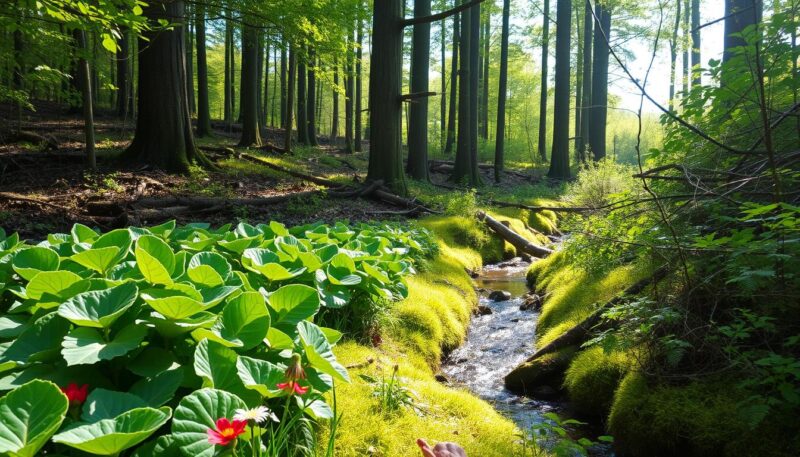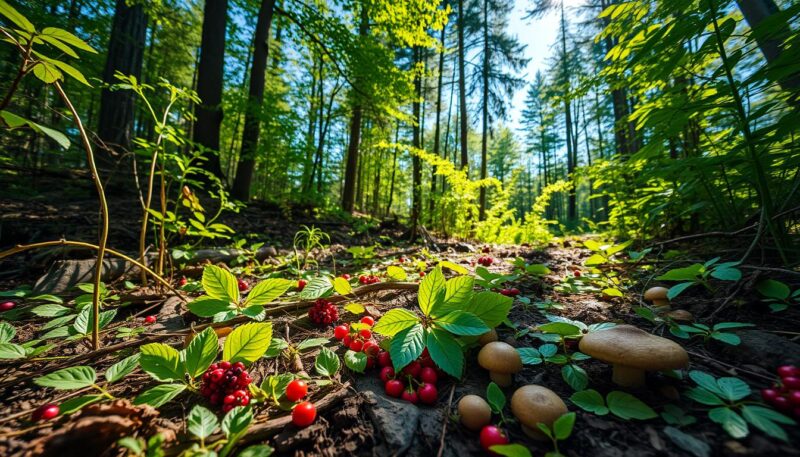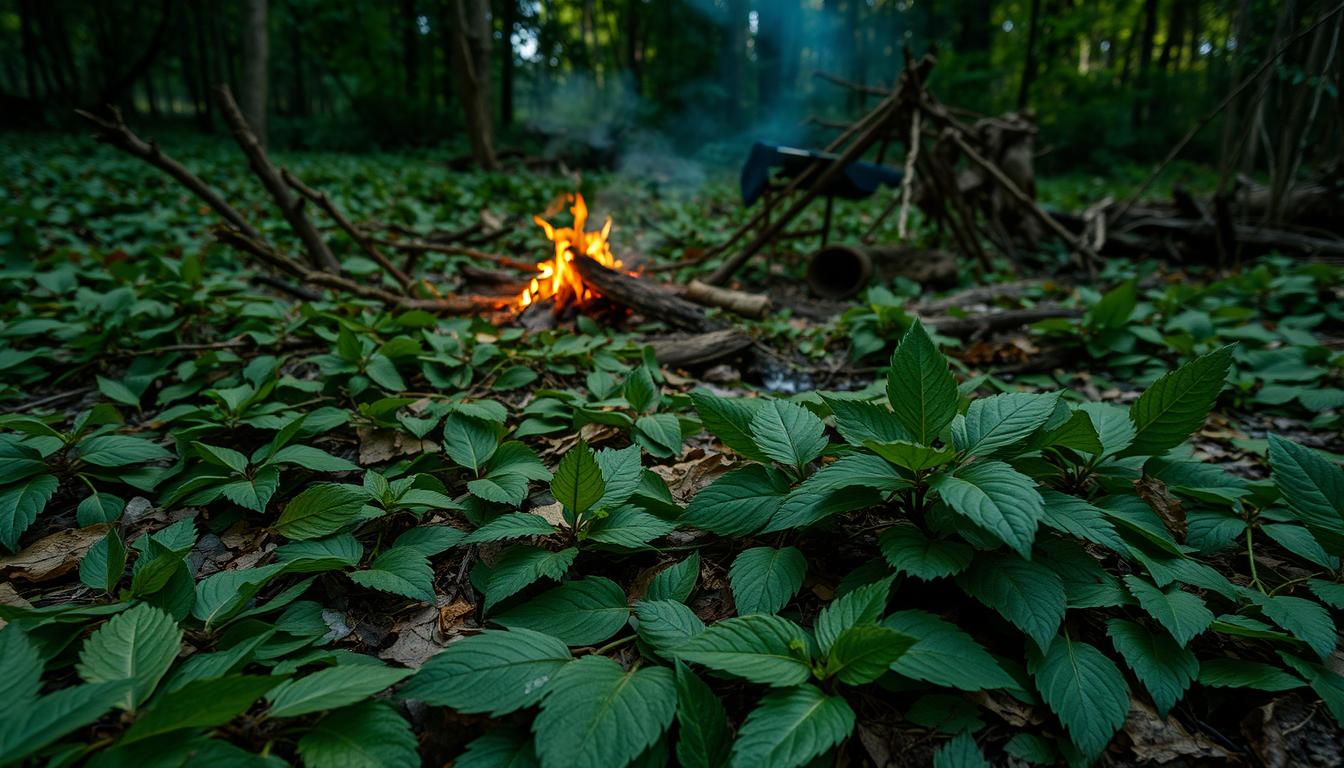When faced with the challenges of wilderness survival, knowing how to find and identify edible plants can be a
lifesaving skill. Whether you’re a seasoned hiker or an outdoor enthusiast, understanding what nature has to
offer in terms of edible vegetation is crucial. In emergency food situations, consuming the right kind of leaves,
roots, and berries can make the difference between just surviving and actually thriving in the wild. This article
explores the essential tips and best practices for eating plants in the wild.
Key Takeaways
- Many grasses and leaves are edible and packed with nutrients essential for survival.
- Learning to identify and harvest wild plants can significantly enhance your survival skills.
- Proper preparation and cooking methods are crucial for safe consumption.
- Seasonal availability of plants influences foraging success.
- Consulting reliable resources and survival experts can help avoid harmful plant consumption.
Understanding Edible Plants for Wilderness Survival
In any wilderness survival scenario, knowing what plants you can safely consume is invaluable. With over 400 types of edible grasses worldwide, and myriad plants offering various nutrients, the forest and fields become a veritable pantry for those in the know. From grasses that provide crucial minerals and vitamins to coniferous trees with edible bark and sprigs, nature’s bounty is vast and varied.
Identifying Edible Leaves
Familiarizing yourself with edible leaves is the first step to successful foraging. Plants like dandelions, chickweed, and plantain are not only nutritious but also commonly found in many areas. Dandelion leaves, for instance, are rich in vitamins A, C, and K, and can be eaten fresh or cooked. Understanding and recognizing these plants in various seasons can optimize your foraging efforts.
Common Edible Plants
Grasses such as wheat, rice, and barley are long known for their health benefits. Apart from the grains, various grasses offer edible leaves that are high in chlorophyll, magnesium, and other minerals. Cattails, often located near water sources, are a robust survival food. Their rhizomes can be roasted or boiled, and the young shoots can be eaten raw or cooked.
Importance of Seasonal Foraging
Seasonality plays a significant role in foraging success. In spring, fresh greens and tubers are abundant, while fall brings a wealth of nuts, berries, and fruits. Understanding the cyclic nature of plant availability will help you plan your survival strategy more effectively.
Safety Tips for Eating Plants in the Wild
While nature provides an abundance of edible resources, not all plants are safe for consumption. Some can be toxic, and misidentifying plants can lead to severe health issues.
Toxic Foliage to Avoid
One of the first rules of wilderness survival is to avoid plants you’re uncertain about. For example, the Pacific Yew tree is toxic, unlike other conifers which are generally edible. Learning to distinguish safe plants from harmful ones is crucial.
Basic Plant Identification Skills
Developing basic plant identification skills will serve you well in the wilderness. Resources like field guides or apps with detailed plant descriptions and images can be incredibly helpful. Familiarize yourself with these tools before venturing out.
Consulting Survival Experts
Reading works by survival experts like Samuel Thayer can provide you with valuable insights. Their experiences and knowledge can equip you with practical skills to identify and safely consume wild plants.
Can You Eat Leaves to Survive?
Leaves may not seem like the most appealing of foods, but they can provide essential nutrients in survival scenarios. Let’s explore how wild greens can be a reliable food source.
Wild Greens as a Food Source
Wild greens, such as mallow and lamb’s quarters, offer a rich source of vitamins and minerals. Mallow leaves are suitable for salads, while lamb’s quarters are packed with nutrients like protein and calcium, making them a valuable addition to your diet.
Nutritious Value of Edible Leaves
The nutritional value of edible leaves cannot be overstated. Many wild plants are superior in nutrient content compared to their cultivated counterparts. Leaves from plants like plantain and clover are high in essential vitamins and minerals, supporting overall health during extended stays in the wild.
Additional Natural Food Sources in Survival Situations
Besides leaves, other natural food sources like roots, nuts, and small game can provide essential nutrition. Understanding these sources can further secure your survival.
Roots and Tubers
Roots and tubers, like those of the cattail plant, are starchy and can be a substantial food source. They can be prepared by roasting or boiling, transforming them into a more palatable and nutritious option.
Nuts and Berries
Nuts, such as acorns, and various berries offer fats and sugars necessary for energy. Ensuring these are properly prepared, like soaking acorns to remove tannins, will make them safe and enjoyable to eat.
Insects and Small Game
For those open to the idea, insects can be a highly nutritious food source. Small game like rabbits and squirrels are also viable options, providing protein and fats crucial for survival.
Fish for Wilderness Survival
Fishing can be one of the most reliable ways to secure food in the wild. All freshwater fish in North America are edible and provide necessary proteins and fats. Properly cooking the fish is essential to kill any harmful microorganisms.
Conclusion
Mastering the skill of identifying and safely consuming wild plants can greatly enhance your wilderness survival experience. By incorporating the knowledge shared here, you can transform a challenging outdoor scenario into an enriching adventure.
Understanding Edible Plants for Wilderness Survival
When it comes to surviving in the wilderness, knowing how to identify edible plants is crucial. You can find a variety of plants throughout the seasons, each offering different nutritional values. This knowledge not only provides a source of sustenance but also ensures that you’re making the safest decisions for your well-being.
Identifying Edible Leaves
One of the first steps in plant identification is understanding which leaves are edible. This skill is vital as many plants have non-edible or toxic look-alikes. Characteristics to look for include the plant’s leaf shape, texture, and color. For example, amaranth leaves are nutritious and easy to spot due to their broad, smooth texture and vibrant green color.
Common Edible Plants
- Amaranth: Contains highly nutritious seeds and young leaves.
- Arrowhead: You can consume the leaves, stalks, and tubers of this plant found in freshwater areas.
- Cattail: Various parts, including rhizomes and young shoots, are edible.
Importance of Seasonal Foraging
Seasonal foraging is integral for maximizing the availability and nutritional value of edible plants. Different seasons bring different plants into their peak. Spring is ideal for foraging greens such as dandelions and wild garlic, while fall brings an abundance of nuts like acorns and various berries. Understanding and adapting to these seasonal changes ensures a continuous supply of food and maintains your nutritional intake throughout the year.
- Spring: Best for foraging greens and tubers.
- Summer: Prime time for a wide variety of fruits and berries.
- Fall: Favorable for nuts and certain root vegetables.
- Winter: Limited, but evergreen plants and some tubers can still be found.
Safety Tips for Eating Plants in the Wild
Foraging for food in the wild demands attention to safety, notably the understanding and avoidance of toxic foliage. Recognizing and avoiding dangerous plant life can be critical for your health and survival. This section focuses on essential tips to ensure you can forage confidently without risking your wellbeing.
Toxic Foliage to Avoid
One of the most crucial wilderness survival skills is knowing which plants to avoid. Toxic foliage, such as certain types of berries, mushrooms, and plant look-alikes, can pose severe health risks. According to survival experts, approximately 50% of red berries and 90% of blue, black, and purple berries are safe. However, you must conduct an edibility test to confirm their safety.
- Green, white, and yellow berries: Around 10% edible.
- Red berries: Approximately 50% edible.
- Blue, black, and purple berries: About 90% edible.
- Aggregate berries: Considered 99% edible worldwide.
Basic Plant Identification Skills
Basic plant identification skills are vital for ensuring plant safety. Recognizing physical attributes such as shape, color, texture, and habitat can help you discern safe plants from toxic ones. For instance, milky sap, fine hairs, spines, umbrella-shaped flower clusters, and waxy leaves are often signs of poisonous plants.
- Observe the plant’s physical characteristics.
- Check for milky or discolored sap and the presence of hairs or spines.
- Note the plant’s location and growth pattern.
- Perform an edibility test on one component of a plant at a time before consumption.
Consulting Survival Experts
Survival experts and credible resources such as seasoned herbalists and survival schools are invaluable for acquiring detailed knowledge about plant safety. Learning from experts can provide insights into which plants have beneficial properties, such as astringency to stop bleeding or purification to cleanse wounds.
| Type of Plant | Usage | Safety Tips |
|---|---|---|
| Berries | Edible or toxic | Always perform an edibility test |
| Underground parts (tubers, roots) | High in starch, best cooked | Bake or boil before consumption |
| Stems and leaves | High vitamin content | Boil or eat raw |
| Flowers | Best consumed raw or in salads | Ensure identification |
Can You Eat Leaves to Survive?
Understanding the role of wild greens in wilderness survival is crucial. Many leaves in the wilderness can indeed be consumed for survival, providing essential nutrients that can be a lifeline when other food sources are scarce.
Wild Greens as a Food Source
Wild greens, such as the young shoots of cattails in the spring or the new growth of conifers, offer a readily available food source in survival situations. These greens can be foraged without the need for specialized tools or licenses, making them a practical option in the wild.

The flexibility of eating plants without needing to hunt or fish significantly simplifies the survival process. One of the major benefits of foraging wild greens is the nutritional value they offer, often surpassing cultivated vegetables in their vitamins and minerals.
Nutritious Value of Edible Leaves
Wild greens are packed with nutritional value, offering vital vitamins and minerals that boost your health. Young leaves from trees like birch, lime, maple, beech, pine, Douglas fir, willow, and hazelnut are particularly beneficial. These greens are not only edible but also often high in vitamin C and other nutrients.
Edible tree leaves can also serve as emergency food sources. While willow leaves contain salicin, a natural pain reliever, pine needles are especially rich in vitamin C, useful either by chewing for juice or making into tea. Hazelnut leaves, which can be used in cooking or as tea, are another example of nutritious wild greens.
However, it is essential to identify these plants accurately to avoid consuming toxic foliage. Tree species such as European yew, Pacific yew, horse chestnut, and manchineel are poisonous and can be dangerous if ingested.
To summarize the key aspects of edible leaves for wilderness survival, consider the following table for comparison:
| Plant | Nutritional Value |
|---|---|
| Birch | Vitamin C rich, edible in spring |
| Pine | High in Vitamin C, usable for tea |
| Willow | Contains salicin, natural pain reliever |
| Hazelnut | Edible leaves, can be used in cooking or tea |
| Maple | Edible young leaves, nutritious |
By understanding the nutritious value of edible leaves and identifying safe wild greens, you can significantly enhance your wilderness survival skills. This knowledge can be the deciding factor in sustaining life when faced with nature’s challenges.
Additional Natural Food Sources in Survival Situations
Survival in the wilderness often requires diversifying your diet beyond edible leaves. Understanding various natural food sources can enhance your chances of sustaining yourself effectively. Foraging can provide you with essential carbohydrates, proteins, and vitamins from a myriad of sources available in nature.

Roots and Tubers
Roots and tubers like burdock and cattail are essential natural food sources. Burdock is popular in Japan and can be consumed raw or boiled. Cattail roots, stems, and leaves are vital for their carbohydrate content, a staple for Native American tribes.
Nuts and Berries
Nuts and berries offer quick energy and are easy to forage. The Hadza hunter-gatherers, for instance, rely on underground tubers of vines, rich in starch, as a fallback food. Ensure you recognize safe-to-eat varieties to avoid any toxic counterparts.
Insects and Small Game
Insects and small game provide a high-protein diet. Consuming insects such as grasshoppers and crickets can be harvested without much effort, while small game like rabbits can be trapped for more substantial meals. Ethical foraging and respect for conservation practices are crucial.
Fish for Wilderness Survival
Fish for wilderness survival can offer a great source of protein and fats. Techniques like passive fishing or hand collection make fish one of the most efficient food resources. Rich in nutrients, including omega-3 fatty acids, fish can play a vital role in your survival diet.
Learning to identify and prepare these natural food sources effectively can make a significant difference in your ability to sustain yourself in the wilderness. Remember, ethical foraging and awareness of legal regulations elevate your survival strategies while ensuring respect for nature.
Conclusion
Surviving in the wild requires a comprehensive approach that goes beyond mere identification of edible plants. It involves understanding the nutritional value of various wild foods such as edible leaves, roots, tubers, nuts, and fish, while also recognizing the importance of safe foraging and preparation techniques. The knowledge garnered from studies in areas like South Ethiopia and the Eastern Black Sea Region of Turkey illustrate how wild edible plants contribute significantly to nutritional and food security in various communities.
For effective wilderness survival, you must combine traditional knowledge with modern survival tips. Reports from regions like the Amhara of Ethiopia and the urban towns of South Africa reveal the intricate balance between utilizing wild vegetables for nutrition and respecting the ecosystems that provide these resources. This holistic approach enables you to see the wilderness not just as an area to endure, but as an environment filled with opportunities and natural abundance.
Ultimately, your ability to thrive in outdoor survival situations hinges on an ongoing learning process. By studying the nutrient compositions of wild plants and engaging with experienced sources, you are better equipped to navigate the unpredictability of nature. Embrace this dual role of learner and explorer to transform your outdoor survival journey into a meaningful engagement with the environment in its purest form.
FAQ
Can you eat leaves to survive in a wilderness survival scenario?
Yes, many leaves in the wilderness are edible and can provide essential nutrients. Learning to identify and harvest these plants safely is crucial for survival in the wild.
What are some essential wilderness survival tips for eating plants in the wild?
Essential tips include identifying edible plants, understanding their seasonal availability, recognizing toxic foliage, and consulting reliable sources like survival experts and trusted guides such as the works of Samuel Thayer.
How can you identify edible leaves?
Basic identification involves recognizing physical characteristics such as shape, color, texture, and habitat. Consulting field guides and experts is also highly recommended.
What are some common edible plants found in the wilderness?
Common edible plants include cattails, acorns, dandelion greens, and young conifer shoots. Each of these provides substantial nutritional benefits.
Why is seasonal foraging important in wilderness survival?
Seasonal foraging is important because different plants mature at different times of the year. For example, spring is ideal for greens and tubers, while fall is best for berries and nuts. Understanding these patterns helps optimize foraging efforts.
What toxic foliage should be avoided when foraging?
Toxic plants include certain types of berries, mushrooms, and look-alike plants. It is crucial to have knowledge of these to avoid severe health risks.
What basic plant identification skills are essential for safe foraging?
Essential skills include recognizing the physical attributes of plants, such as leaf shape, color, and growth environment, which help distinguish edible plants from poisonous ones.
Why should you consult survival experts when learning about edible plants?
Survival experts provide valuable knowledge and experience, ensuring that the information is accurate and reliable. They can offer guidance on proper foraging techniques and safety practices.
Are wild greens a good food source for survival?
Yes, wild greens such as young shoots of cattails and new growth of conifers are nutritious and readily available, making them excellent sources of sustenance in survival situations.
What nutritional value do edible leaves offer?
Edible leaves are often rich in vitamins, minerals, and other beneficial compounds. They can provide essential nutrients that support health and energy levels during survival scenarios.
What other natural food sources can be found in survival situations?
Other natural food sources include roots and tubers, nuts and berries, insects, small game, and fish. Each provides different nutrients, making them valuable additions to a survival diet.
How can roots and tubers be utilized for survival food?
Roots and tubers are rich in carbohydrates and can be cooked in various ways to provide necessary energy. Proper identification and preparation, such as leaching tannins from acorns, are crucial for safety and edibility.
Why are nuts and berries important in a survival diet?
Nuts and berries offer fast energy due to their high fat and sugar content. They are often abundant in the wild and easy to collect.
Can insects and small game be considered viable food sources in the wild?
Yes, insects and small game are rich in protein and can be readily found in various environments. Learning trapping and cooking techniques ensures their safe consumption.
How important is fish for wilderness survival?
Fish is extremely valuable due to its high nutrient density. Passive fishing methods make it a relatively easy and efficient food source in survival situations.
Source Links
- https://wildernessawareness.org/articles/survival-food-plants-cattail-acorns-grasses-and-conifers/
- https://www.wildernesscollege.com/survival-foods.html
- https://uspreppers.com/why-leaves-may-be-the-most-useful-survival-item-ever/
- https://fieldcraftsurvival.com/blog/survival-wild-edible-plants/
- https://www.holisticsurvivalschool.com/news/2019/8/31/11-survival-plants-everyone-should-know
- https://www.universalclass.com/articles/self-help/nourishing-with-plants-fruits-and-bugs-for-wilderness-safety.htm
- https://www.beprepared.com/blogs/articles/survival-101-foraging-for-edible-plants-1?srsltid=AfmBOooU_1d4Ciz5bXQqpSHrlQkx2OsLSodad4wocUD2LB3FvZHMv7KN
- https://ask.metafilter.com/130374/Why-dont-we-eat-the-leaves-off-the-trees
- https://survival-kompass.de/en/tree-leaves-eating/
- https://www.artofmanliness.com/skills/outdoor-survival/surviving-in-the-wild-19-common-edible-plants/
- https://paulkirtley.co.uk/2013/survival-foraging-a-realistic-approach/
- https://www.ncbi.nlm.nih.gov/pmc/articles/PMC7487116/
- https://gardenbetty.com/tomato-leaves-the-toxic-myth/
- https://wildfoodgirl.com/2016/eating-chicory-greens/

